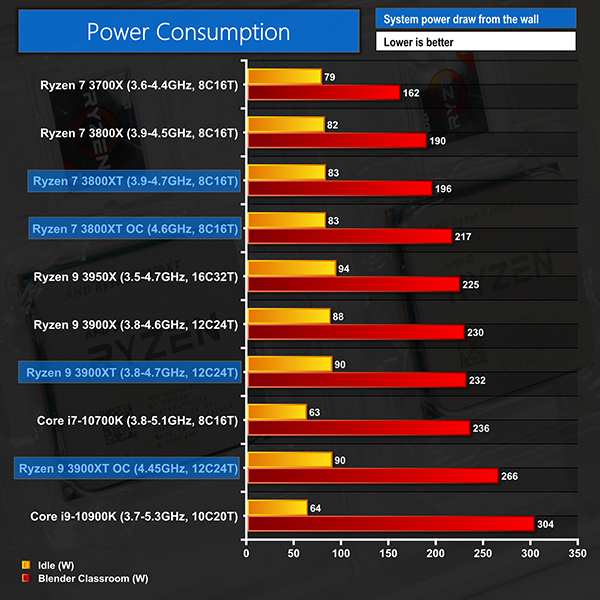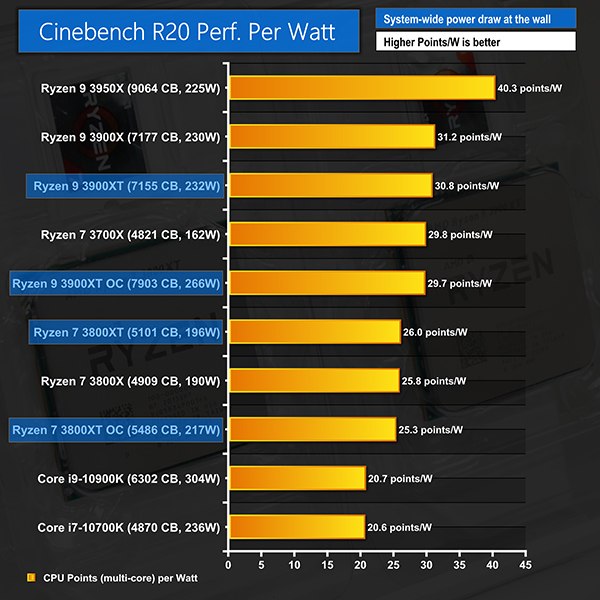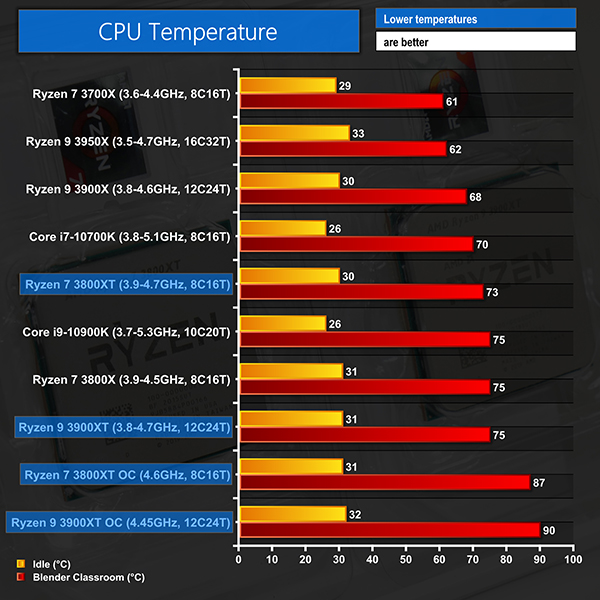We leave the system to idle on the Windows 10 desktop before taking a power draw reading. For CPU load results, we read the power draw while producing five minutes' worth of loading in the Blender Classroom rendering test.
The power consumption of our entire test system (at the wall) is shown in the chart. The same test parameters are used for temperature readings.
Power Consumption
Power draw readings are accurate to around +/-5W under heavy load due to instantaneous fluctuations in the value. We use a Titanium-rated Seasonic 1000W Prime PSU.
All-core load power draw for the Ryzen 7 3800XT is slightly higher than the other eight-core Ryzens simply because it runs faster. AMD’s under-the-hood tweaks will have improved the XT chip behaviour of the V-F curve, but the individual processors can still draw more power if they are simply operating at a higher clock speed.
The 3900XT matches the 3900X’s power numbers because its 4050MHz operating frequency is the same. 266W of system-wide power consumption is a comfortable and easy-to-manage level for a 4.45GHz overclocked 12-core chip. This is a strong positive for the overclocking experience with AMD’s Ryzen 3000XT chips.
Versus the 10700K and 10900K in their boost duration unlimited operating states, the Ryzen 7 3800XT and Ryzen 9 3900XT consume significantly less power. AMD’s 12-core chip actually draws a little less than Intel’s 8-core.
Even when stock clocked or overclocked highly, Zen 2 in the Ryzen 3000XT form maintains preferential power efficiency versus Intel’s 10th Gen chips and their Skylake-based architecture and refined 14nm process node.
Performance per Watt
Power efficiency in Cinebench R20 nT is biased towards higher core count chips. Nevertheless, it is clear to see Ryzen 3000XT delivering significantly better power efficiency results than the Intel 10th Gen competitors.
The Ryzen 3000X and 3000XT chips are basically the same in terms of power efficiency (accounting for compounded error margins in our test data). But the reduced TDP of the lower cost Ryzen 7 3700X makes it far superior in terms of eight-core power efficiency, if that is important to you.
Temperatures
Temperature recordings were taken using the Fractal Celsius+ S28 Prisma 280mm AIO CPU cooler at full fan and pump speed. Ambient temperatures were around 24-25°C.
Zen 2 has always shown a rather sizable thermal sensitivity to operating voltage and frequency.
Despite running at higher clock speeds and drawing more power, our Ryzen 7 3800XT roughly matched the operating temperature of our early batch Ryzen 7 3800X.
It was, however, surprising to see the 3900XT running several degrees hotter than our early-2020 3900X with similar clock speed and power draw.
We re-checked this data a few times, and tested with a different motherboard and 280mm AIO, but we still saw the same behaviour. This is, perhaps, one of those chip to chip quirks.
You are going to need good cooling to run the Ryzen 7 3800XT and Ryzen 9 3900XT proficiently. That is especially true when adding in the higher temperature behaviour under AIDA stress testing load, or with the added voltage and frequency of overclocking. AMD’s decision to omit the Wraith coolers from the bundle is probably vindicated from a thermal perspective.
Be sure to check out our sponsors store EKWB here
 KitGuru KitGuru.net – Tech News | Hardware News | Hardware Reviews | IOS | Mobile | Gaming | Graphics Cards
KitGuru KitGuru.net – Tech News | Hardware News | Hardware Reviews | IOS | Mobile | Gaming | Graphics Cards





